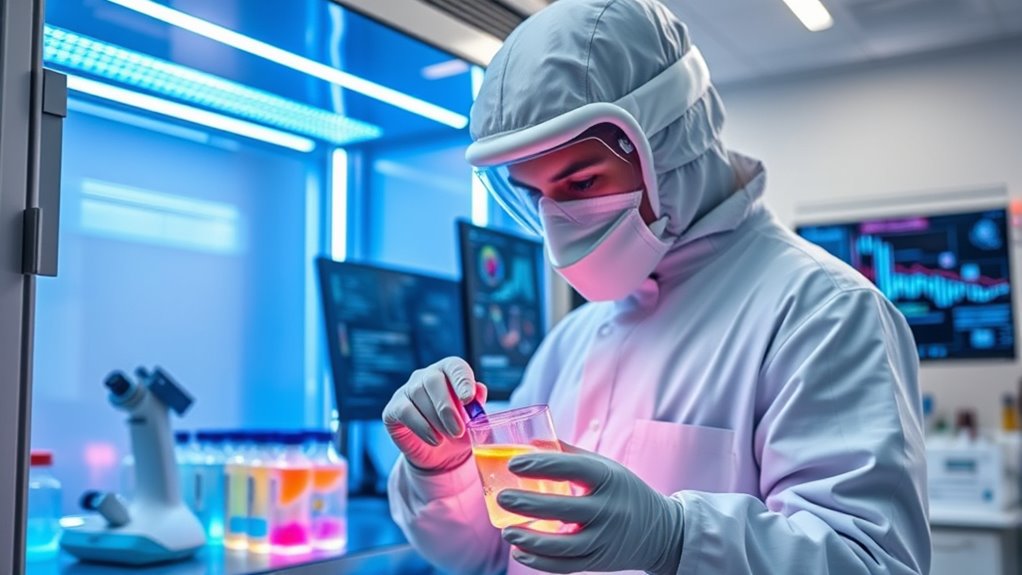Balancing innovation in synthetic biology with biosecurity involves implementing strict protocols, proper training, and regular safety checks to prevent accidental releases and malicious misuse. You should stay aware of ethical guidelines, engage with regulatory bodies, and foster a culture of responsibility within your team. By doing so, you can help guarantee that biotech advancements benefit society without introducing unacceptable risks. If you continue exploring, you’ll discover effective strategies to manage these essential concerns successfully.
Key Takeaways
- Implement robust biosecurity protocols alongside innovation to prevent misuse and accidental releases of engineered organisms.
- Foster a culture of responsibility through training and ethical awareness among researchers working with synthetic biology.
- Regularly review and update safety procedures to adapt to evolving biotech advancements and emerging risks.
- Engage with regulatory agencies and international bodies to ensure compliance and promote responsible innovation.
- Balance scientific progress with ethical considerations and risk assessments to maximize societal benefits while minimizing potential harm.

Innovations in biotechnology hold the promise of groundbreaking medical treatments and solutions to global health challenges, yet they also introduce significant bio-risk concerns. As you explore the rapidly evolving landscape of biotech, synthetic biology stands out as a transformative force. It allows you to design and construct new biological parts, devices, and systems, opening doors to personalized medicine, sustainable agriculture, and environmental remediation. However, with this power comes the responsibility to implement robust biosecurity protocols. These protocols serve as critical safeguards to prevent misuse or accidental release of engineered organisms that could threaten public health or biodiversity. When working with synthetic biology, you must be vigilant, ensuring that strict containment procedures are in place, and access to sensitive tools and information is carefully controlled. This means adhering to established biosecurity standards, such as secure laboratory practices, thorough risk assessments, and ongoing oversight.
You might think that innovation should always take precedence, but neglecting biosecurity measures can lead to catastrophic consequences. For example, improperly contained genetically modified organisms could escape laboratory settings and disrupt local ecosystems or be exploited maliciously. This risk underscores the importance of balancing your pursuit of innovation with diligent bio-risk management. Developing safe protocols is not just about compliance; it’s about proactively safeguarding society from potential threats. This includes training personnel on biohazard handling, regularly auditing safety procedures, and fostering a culture of responsibility within your research environment. As synthetic biology advances, so too must your commitment to biosecurity, ensuring that the benefits of your innovations do not come at an unacceptable cost.
Moreover, understanding the ethical considerations associated with bioengineering can help you anticipate societal concerns and foster responsible research practices. Furthermore, engaging with regulatory agencies and international organizations helps you stay aligned with evolving standards. Many countries now require extensive biosafety reviews and ethical assessments before approving new biotech projects. Participating in these processes keeps you informed of best practices and emerging risks. By doing so, you contribute to a global effort to manage bio-risks effectively while still pushing the boundaries of scientific discovery. Ultimately, your challenge is to find the delicate balance where innovation flourishes without compromising safety. Embracing a proactive stance on biosecurity protocols enables you to harness the full potential of synthetic biology responsibly. In doing so, you help ensure that biotech advancements serve humanity’s best interests, safeguarding both public health and the environment for generations to come.
Frequently Asked Questions
How Can Small Startups Ensure Bio-Safety Compliance While Innovating?
You can guarantee bio-safety compliance by staying informed about regulations and implementing strict protocols. Address ethical dilemmas early to build trust and avoid setbacks. Seek funding challenges as opportunities to demonstrate your commitment to safety, making compliance a priority to attract investors. Collaborate with experts and conduct thorough training. This proactive approach keeps your startup innovative while maintaining the highest standards of bio-safety, helping you navigate risks effectively.
What Are the Latest Technological Tools for Bio-Risk Assessment?
You can utilize the latest technological tools like advanced biosurveillance systems and genetic editing techniques to assess bio-risk effectively. Biosurveillance systems enable real-time monitoring of pathogen spread, helping you identify threats early. Genetic editing tools, such as CRISPR, allow precise modifications to understand risks better. Combining these technologies enhances your ability to evaluate and mitigate bio-risks while fostering innovation safely. Stay updated on emerging tools to maintain compliance and protect public health.
How Do International Regulations Influence Bio-Innovation Practices?
International regulations shape your bio-innovation practices by setting global standards that you must follow. These standards guarantee safety and consistency across borders, guiding your research and development. Ethical considerations are central, prompting you to evaluate potential risks and societal impacts. By adhering to these regulations, you demonstrate responsibility, foster trust, and facilitate international collaboration, ultimately helping you innovate safely while respecting global norms and ethical principles.
What Role Do Public Perceptions Play in Balancing Innovation and Bio-Risk?
You might think public perceptions aren’t essential, but they’re actually key in balancing innovation and bio-risk. Public trust can accelerate or hinder scientific progress, especially when media influence shapes opinions. If the public fears risks, regulators may impose stricter controls, stifling innovation. Conversely, positive perceptions foster support, encouraging responsible advancements. Your role in transparent communication helps build trust, ensuring innovation proceeds without unnecessary restrictions.
How Can Policymakers Foster Safe Biotech Advancements Without Stifling Innovation?
You can foster safe biotech advancements by developing clear regulatory frameworks that prioritize ethical considerations, ensuring safety without hindering innovation. Engaging stakeholders, including scientists and the public, builds trust and guides responsible research. Additionally, adopting innovative funding strategies, like grants for high-risk projects, encourages progress while maintaining safety standards. This balanced approach promotes innovation and safeguards public health, creating an environment where biotech can thrive responsibly.
Conclusion
As you navigate the world of biotech, remember that balancing innovation with bio-risk is essential. Did you know that over 70% of biotech startups now prioritize safety protocols alongside breakthroughs? By embracing responsible practices, you can help guarantee that advancements benefit society without unintended harm. Staying vigilant and proactive allows you to innovate confidently, knowing you’re contributing to a safer, more sustainable future. Keep pushing boundaries, but always with safety in mind.









